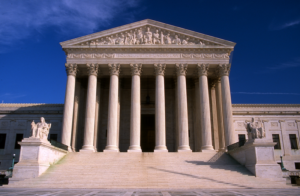The Supreme Court is entering the final stretch of its annual session, with just about six weeks remaining to resolve a significant number of cases. Among the pressing matters still awaiting their decisions are issues that carry far-reaching implications for society. These include the future of race-based admissions practices at colleges, the scope of federal voting-rights law, an Andy Warhol copyright challenge, and the validity of the Biden administration’s student loan forgiveness program.
Interestingly, the late Justice John Paul Stevens, whose papers have recently been made accessible at the Library of Congress, sheds light on the inner workings of the Court during these critical moments. The private one-on-one conversations documented in his papers, spanning from the early 1990s to 2004, provide valuable insights into the intense negotiations that take place behind closed doors as cases approach their resolution. These papers offer a unique perspective, complementing other interviews and research conducted over the years, and help paint a more complete picture of the High Court’s workings under deadline pressure.
 The Supreme Court is no stranger to handling high-stakes cases, and as the session nears its end, the justices are faced with a mounting workload. Each case carries its own complexities, legal considerations, and potential implications for the nation. The issue of race-based admissions practices at colleges, for instance, touches upon fundamental questions of equality, diversity, and the pursuit of educational opportunities. A decision in this case could have a lasting impact on the future of affirmative action policies and the composition of college campuses nationwide.
The Supreme Court is no stranger to handling high-stakes cases, and as the session nears its end, the justices are faced with a mounting workload. Each case carries its own complexities, legal considerations, and potential implications for the nation. The issue of race-based admissions practices at colleges, for instance, touches upon fundamental questions of equality, diversity, and the pursuit of educational opportunities. A decision in this case could have a lasting impact on the future of affirmative action policies and the composition of college campuses nationwide.
Similarly, the Court’s ruling on the protective scope of federal voting-rights law holds immense significance for our democracy. The outcome could shape the extent to which voting rights are safeguarded and ensure fair and equal access to the ballot box for all citizens. Given the ongoing debates surrounding voting rights and access, this case has the potential to shape the trajectory of our electoral system for years to come.
The Court also faces a copyright challenge involving the iconic artist Andy Warhol. This case delves into the realm of intellectual property rights and the boundaries of artistic expression. The decision reached here will not only affect the specific circumstances surrounding Warhol’s work but may also set precedents for copyright law and artistic freedom in the digital age.
In addition to these headline-grabbing cases, the justices will also tackle the validity of the Biden administration’s student loan forgiveness program. With mounting concerns over the rising burden of student debt, this case holds significant implications for millions of borrowers and the future of higher education affordability. A ruling in favor of the program could provide relief to many struggling individuals, while a decision against it could impact the government’s ability to address the student debt crisis.
As the justices deliberate over these cases and many others, the country eagerly awaits their decisions. The Supreme Court plays a pivotal role in shaping the legal landscape of the United States, and the outcome of these cases will have far-reaching consequences that extend beyond the courtroom. With the clock ticking and the annual session coming to a close, the Court’s decisions will undoubtedly leave an indelible mark on the nation’s history and define the trajectory of key issues for years to come.